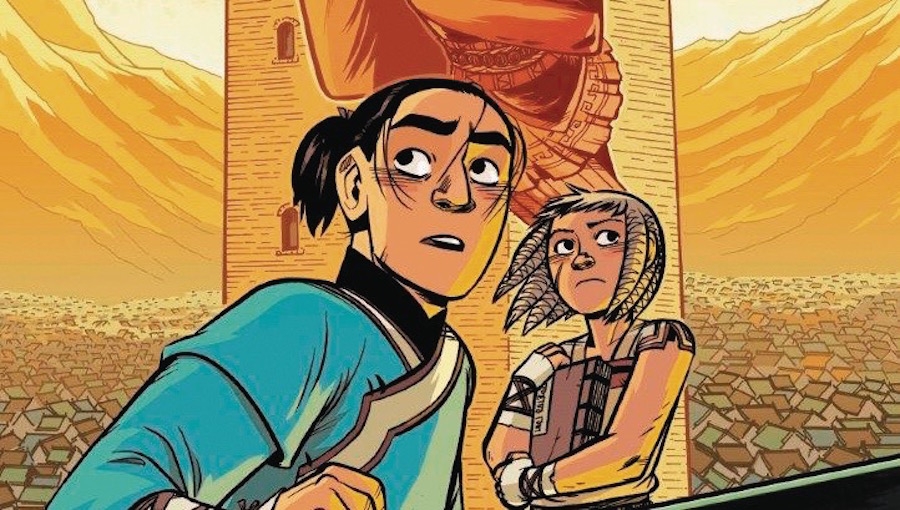The Stone Heart, the second installment in Faith Erin Hicks’ The Nameless City trilogy, picks up a few months after the events of the first volume. (Check out my review of The Nameless City, the first volume in The Nameless City trilogy by Faith Erin Hicks.) Rat and Kai are at their leisure in the palace. Rat’s leg is healing, and she’s almost ready to challenge Kai to fresh parkour racing through the city. Kai’s father, Andren, is hard at work negotiating deals to get the Council of Nations up and running. The General of All Blades is grappling with his son’s ambitious nature, and Maru continues to harbor mysterious, manipulative motivations.
Thankfully, while Kai and Rat’s developing friendship is still the obvious center of the story, The Stone Heart spends significantly more time with various other relationships. We delve into Maru and Erzi’s backstory, which starts to shed some light on the motivations behind Maru’s scheming. Kai and Andren are forced to confront their fragile father/son relationship. The General reveals his reasons for not wanting Erzi to succeed him as ruler.
Many of these relationship pairs form intriguing mirrors. The fathers, Andren and The General, claim a similar reason for the troubled nature of their relationships with their respective sons, Kai and Erzi. And while the reason is noble, wanting to protect their sons from a lifetime of war, the result is misunderstanding, distrust, and resentment. Rat and Maru, our two native orphans, also highlight each other, particularly in their very different reactions to the trauma of their childhoods.
The theme we spend the most time on in The Stone Heart, however, is the vast and devastating effects of continual warfare and occupation on both conqueror and victim. Hicks focuses in particular on the Dao conquering nation and their exhausting effort to maintain rule over the city with many other nations and internal factions working against them. Kai, in particular, is deeply affected by the assumption that he is destined to be a “warrior Dao,” and his feeling of responsibility for the suffering the Dao have caused in the city.
While I continue to find the characters engaging, the story interesting, and the artwork beautiful, The Nameless City still feels like “the mostly uninhabited city.” The characters feel isolated from the population at large. Wide views of the city are spectacularly beautiful, but are lacking in a sense of a teeming population. I still do not see the scope of poverty-driven squalor that the story seems to require.
I did, however, appreciate the focus this volume achieved in moving the story forward. Introductions are over and the narrative is moving forward with purpose and more than one shocking turn of event. I am certainly hooked into sticking around for Volume 3 and the conclusion of this story.
Entertainment Weekly reported on April 3rd that The Nameless City saga as been picked up by Frederator Studios who will adapt the trilogy into 12 animated episodes (Each graphic novel will get 4 episodes.) that will start airing in late 2018. I suspect that the animated version of this story will work better for me, as it will be easier to depict the energy and motion of the story, as well as give a better sense of the sprawling metropolis the character’s inhabit.

